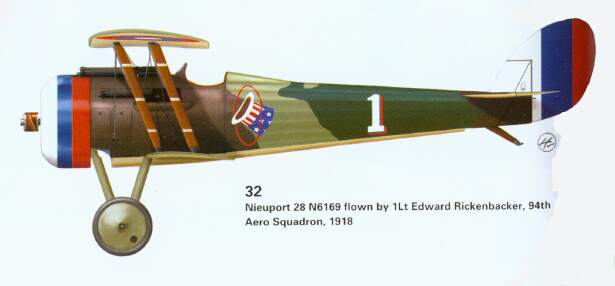

78 miles per hour!
In 1911, at the third competition for the Gordon Bennett trophy in Eastchurch, England, an American aviator, Charles Weymann, won the cup while flying an extraordinary new monoplane - the Nieuport II. With an overall speed of 78 MPH, but allowing for turns, he must have done around 90 miles an hour on the straightaways. This airplane was small, but fast, fast, fast: speed which would serve its successor biplanes well in WWI, starting with the Nieuport 11. In comparison to the lumbering Wright & Curtiss biplanes of the day [...]
Read the full story of the Nieuport II Monoplane here.
This machine, better known as the type militaire, resembled in detail the other Bleriot products, but differed greatly in size, in the fact that it was a two-seater, and in the construction of the fan-shaped tail. Like all the later Bleriot products, the dashboard in front of the seats was equipped [...]
Read more about the BLERIOT XI. 2 BIS here.
A stream of gasoline burst forth as Gustav Hamel flew over the Thames River on September 20, 1913. The last thing any aviator needed in a wood and cloth monoplane with a barely-covered, hot, sparking, rotary engine a few feet away was gasoline in the cockpit. It was a mortal danger for any pilot, and surely the end of the race for Gustav Hamel, competing in the Daily Mail's Aerial Derby around London. Hamel had been the last to start and had just overtaken [...]
Read the whole article about the Morane-Saulnier Type H.
How do you fire a machine gun through the arc of a spinning propeller? Early in 1915, aviators engaged in the First World War wanted to solve that problem. Obviously, the bullets of the machine gun would smash a propeller to bits. Early in the war airmen had fired at each other with limited efficiency, the best results having been obtained in two-seaters, with the observer shooting while the pilot flew the plane. Pusher airplanes, with the propeller in back, also provided a clear field of forward fire.
But clearly the best solution would be for the pilot, in a fast, single-seat airplane, to have a machine gun right in front of him, enabling him to [...]
Read more about Roland Garros and the Morane-Saulnier L here.
The French answer to the Fokker Eindekker was the Nieuport 11, equipped with the 80 horse-power Le Rhône (later the 110 horse-power), and armed with a Lewis gun, mounted on the top plane and shooting over the propeller. The machine was superior to the Fokker - all WWI pilots agreed [...]
Read the full story of the Nieuport 11 here.
The most successful of the Nieuport biplanes of WWI, flown by the French, British, Americans, Italians, and Russians. Often referred to in contemporary sources as the "15 meter" Nieuport (based on its total wing surface). During the summer of 1916, many months after the appearance of the Fokker, the French produced the Nieuport 17, armed with [...]
Read more about the Nieuport 17 here.
This late variant of Nieuport's biplanes was used mainly by American pilots, notably Eddie Rickenbacker, the French having switched over to Spads. The Type 28 looked quite different from the earlier Nieuports: it had a longer, rounded fuselage; it dispensed with the sesquiplane configuration (and the associated V struts); and it had rounded, not angular wingtips. [...]
Read more about the Nieuport 28 here.
With a distinctive large spinner, the Morane-Saulnier N looks, at least to the modern eye, better than the Parasol Type L, it met with much less success. While the Type N was a graceful-looking aircraft, with an advanced, aerodynamic design, it was not easy to fly due to its stiff controls (using wing warping instead [...]
The famed American volunteers of the French Lafayette Escadrille were flying the SPAD VII in February 1918 at the time they transferred to the U.S. Army Air Service, becoming the 103rd Aero Squadron. Several other U.S. units also used the SPAD VII, although most American Expeditionary Force (AEF) fighter squadrons were equipped with [...]
Read more about the Spad VII here.
One of the best fighters of World War One, widely used by French, American, and other Allied squadrons, 8,472 being produced. In 1916 a new generation of German fighters threatened to win air superiority over the Western Front. The French aircraft company, Société pour l'Aviation et ses Dérives (SPAD), responded by [...]
For World War One, the Morane-Saulnier A-1 had very modern lines and was very streamlined; it resembles small airplanes that you can see today at any general aviation airport. 1,210 were produced, but it never made a big impact at the front. Not long after its introduction it was withdrawn to serve as trainers, as [...]
Read the whole article about the Morane-Saulnier A-1.
The Farman Brothers were among the pioneers in French aviation, Henri Farman winning several of the prizes offered in the first years of aviation development with his early machines. He came to this country for one of the International meets but, being a very conservative flyer, proved a disappointment to American spectators. From this beginning, [...]
Read a longer article about Farman Fighters here.
In 1920, the Nieuport-Delage Ni-D 29 was the fastest airplane in the world. Designed by the Nieuport firm for the French Aviation Militaire in 1918, the Ni-D 29 appeared too late for combat in WWI. Following its record-breaking performance in the 1920 Gordon Bennett Trophy race, when it flew 168 miles per hour, it was [...]
Read the whole article about the Nieuport-Delage 29.
Sources:
Questions? Check the FAQ.
Copyright 2011, by Acepilots.com. All rights reserved.